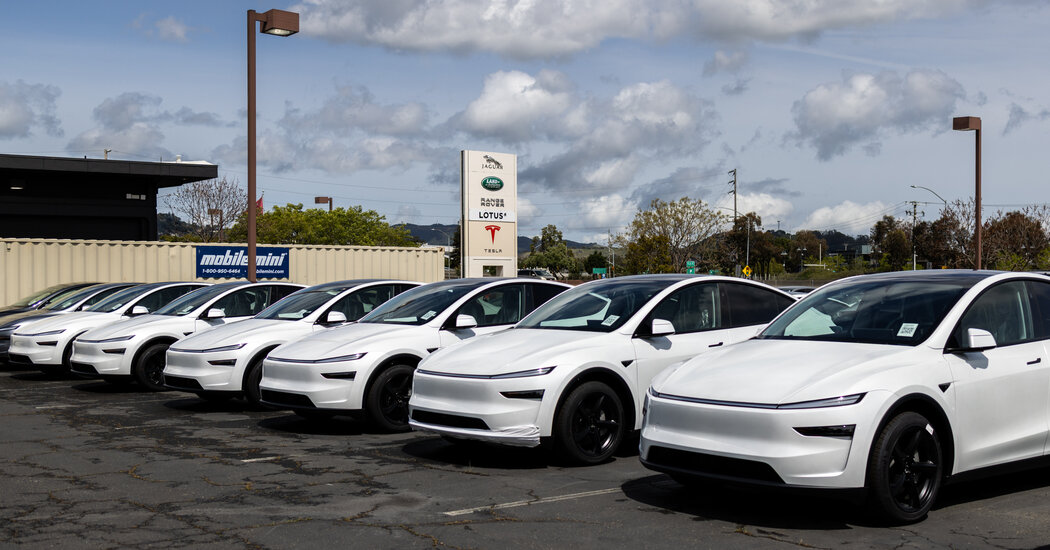
The key factor that nudged Dan McGrath and his wife to lease a Hyundai Ioniq 5 sport-utility vehicle in August was the impending end of a $7,500 federal tax credit available to people who get a new electric vehicle.
“We knew that with the Sept. 30 deadline, it was now or never, so we did it,” said Mr. McGrath, 38, who works as a transportation planner in Cincinnati. “The car became much more affordable with the tax credit.”
Across the country, thousands of people have been making the same calculation, leading to a surge of electric car sales. In August, sales jumped 18 percent, to 146,332 vehicles, and analysts expect another big increase in September.
But the demise of the tax credit will probably bring the party to an end. Sales of electric models are expected to plummet in the last three months of the year and then remain sluggish for some time.
“Next year could be a pretty dreadful year for E.V.s in this country,” Adam Jonas, who covers the auto industry at Morgan Stanley, said earlier this month at a conference hosted by his firm.
Bracing for this new environment, automakers are slowing production of battery-powered cars, delaying or scrapping new models and shifting capital and other resources into gasoline and hybrid vehicles.
It all marks a stark turnaround from the heady days a few years ago when many automakers believed electric vehicles were poised to take off.
This new era of lower sales is largely a result of policy changes made by President Trump and Republicans in Congress who have long opposed subsidies for electric vehicles. Mr. Trump often refers to climate change as a “hoax” or a “con job” and has characterized the climate and energy policies of his predecessor, Joseph R. Biden Jr., as the “green new scam.”
Republican lawmakers have also suspended penalties for automakers who fail to hit federal fuel-economy targets, and Mr. Trump has raised tariffs on imported cars.
All of those changes mean that manufacturers are now under much less pressure to sell more electric models. And since most automakers other than Tesla are not yet making money on these cars, lower sales should also mean smaller losses.
Many established automakers will now put more effort into making and selling gasoline vehicles, including hybrids that use engines as well as electric motors and batteries.
Paul Jacobson, the chief financial officer of General Motors, said his company is now shifting its emphasis from adding more electric models and increasing E.V. sales to lowering the cost of making those vehicles.
“The reality is we’re probably going to scale up much slower now over the next few years,” he said this month at an investment conference. “But we’re in a position now where we have the opportunity to deploy the capital into electric vehicles not to proliferate the portfolio, but rather to focus on structural cost reductions within E.V.s.”
G.M. this month idled a factory in Hamtramck, Mich., where it makes several electric models. Production at another plant in Tennessee is now scheduled to be suspended for a week in each of the next two months and for all of December. When it reopens in January, it will run one shift instead of two.
Other manufacturers are taking similar steps. Honda has scrapped an electric Acura. Stellantis canceled a battery-powered Ram pickup. And Nissan will no longer import its Ariya electric sport-utility vehicle from Japan.
Ford Motor, whose electric vehicle division has been losing billions of dollars a year, is overhauling its strategy, and plans to offer several new, affordable models but not until 2027. The company has said it aims to sell a new pickup for around $30,000, well below the electric models it sells now.
While established automakers can adjust to a smaller market for electric vehicles, newer companies like Tesla and Rivian face a tougher challenge because they don’t have gas-powered vehicles to fall back on. And they are losing a key source of revenue — selling emission credits to older automakers.
For years, companies like G.M., Stellantis, BMW and others didn’t sell enough zero-emissions vehicles to comply with federal clean-air regulations. So they have been buying credits from electric vehicle companies.
Selling credits has generated hundreds of millions of dollars in profits for Tesla every year. In the second quarter, the company made $439 million from regulatory credit sales, contributing to its $1.2 billion quarterly profit.
Still, most industry executives believe electric vehicle sales will eventually grow again, especially if automakers can deliver models that sell for around $30,000.
Analysts from J.D. Power recently noted that electric vehicle sales fell sharply in Germany and Canada after those countries ended subsidies in December 2023 and January 2025 but eventually started growing again. A similar pattern could play out in the United States.
“These are cars that people like,” said Albert Gore III, the executive director of the Zero Emission Transportation Association, a trade group. “They’re ultramodern, and they’re fun to drive. Some manufacturers have decided to scale back their pace, but I think those who continue to bring compelling, affordable E.V.s in high volume will be richly rewarded.”



